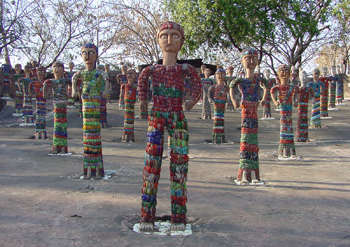Chandigarh, the dream city of India's first Prime Minister, Sh. Jawahar Lal Nehru, was planned by the famous French architect Le Corbusier. Picturesquely located at the foothills of Shivaliks, it is known as one of the best experiments in urban planning and modern architecture in the twentieth century in India.
Chandigarh derives its name from the temple of "Chandi Mandir" located in the vicinity of the site selected for the city. The deity 'Chandi', the goddess of power and a fort of 'garh' laying beyond the temple gave the city its name "Chandigarh-The City Beautiful".
The city has a pre-historic past. The gently sloping plains on which modern Chandigarh exists, was in the ancient past, a wide lake ringed by a marsh. The fossil remains found at the site indicate a large variety of aquatic and amphibian life, which was supported by that environment. About 8000 years ago the area was also known to be a home to the Harappans.
Since the medieval through modern era, the area was part of the large and prosperous Punjab Province which was divided into East & West Punjab during partition of the country in 1947. The city was conceived not only to serve as the capital of East Punjab, but also to resettle thousands of refugees who had been uprooted from West Punjab.
In March, 1948, the Government of Punjab, in consultation with the Government of India, approved the area of the foothills of the Shivaliks as the site for the new capital. The location of the city site was a part of the erstwhile Ambala district as per the 1892-93 gazetteer of District Ambala. The foundation stone of the city was laid in 1952. Subsequently, at the time of reorganization of the state on 01.11.1966 into Punjab, Haryana and Himachal Pardesh, the city assumed the unique distinction of being the capital city of both, Punjab and Haryana while it itself was declared as a Union Territory and under the direct control of the Central Government.
 Location: in Sector 1 between the Capitol Complex and Sukhna Lake
Location: in Sector 1 between the Capitol Complex and Sukhna Lake
Highlights: exquisite artwork made from industrial and urban waste
Chandigarh rock garden is an epitome of creativity and innovation. It is a unique garden that consists of various art objects. But the best part about the rock garden is that each of its artwork has been made by using industrial & urban waste. It is located in Sector 1 between the Capitol Complex and Sukhna Lake. The credit for laying its foundation goes to Nek Chand, who was the then Road Inspector in the Engineering Department of Chandigarh Capital Project.
Rock garden has been established in the form of an open-air exhibition hall. The garden houses sculptures made by using a variety of different discarded waste materials like frames, mudguards, forks, handle bars, metal wires, play marbles, porcelain, auto parts, broken bangles etc. Rock garden in Chandigarh, India is a unique creation and connoisseurs come from different parts of the world to see this amazing garden.
Location: in the foothills of Shivalik range
Highlights: manmade lake
 Sukhna Lake is a beautiful lake that lies in the foothills of Shivalik range. The unique thing about Sukhna is that it is a manmade lake. It is a 3 km long lake that was created in the year 1958. It was done by damming the Sukhna Choe, which is a seasonal stream flowing down from the Shivalik hills. Sukhana Lake of Chandigarh, India has become an integral part of the city
Sukhna Lake is a beautiful lake that lies in the foothills of Shivalik range. The unique thing about Sukhna is that it is a manmade lake. It is a 3 km long lake that was created in the year 1958. It was done by damming the Sukhna Choe, which is a seasonal stream flowing down from the Shivalik hills. Sukhana Lake of Chandigarh, India has become an integral part of the city
People visit this place in the morning to enjoy the cool breeze and the beauty of nature. Chandigarh Sukhna Lake serves as a great picnic spot and an apt place for pursuing water sport activities like boating, yachting and water skiing etc. The atmosphere over here is very serene and thus apt for meditating. Also, you can savor the melodious humming of birds. People come here in the evening time to forget their worries and relax for a while. So, if you want to rejuvenate yourself, then Sukhna Lake is the perfect destination for you.